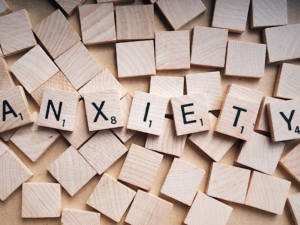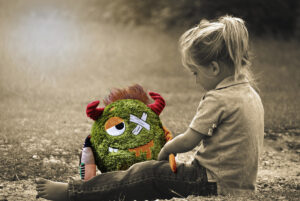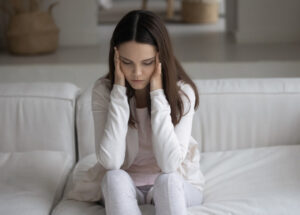By: Katie Clark, LPC and Jennifer Munroe, LPC
 Anxiety is incredibly common in children and adolescents. According to the National Institute of Mental Health, an estimated 31.9% of adolescents meet criteria for an anxiety disorder with a median onset age of six years old. Despite this, it is frequently misunderstood by both the young children experiencing these symptoms and their support systems.
Anxiety is incredibly common in children and adolescents. According to the National Institute of Mental Health, an estimated 31.9% of adolescents meet criteria for an anxiety disorder with a median onset age of six years old. Despite this, it is frequently misunderstood by both the young children experiencing these symptoms and their support systems.
Often, children and their caregivers do not realize anxiety can have physical effects. Children can experience various physical symptoms related to anxiety such as stomach aches, headaches, indigestion, muscle tension, nausea, fatigue, sleep disruption, and restlessness. Physical symptoms like these should always first be medically explored to rule out other underlying causes. That being said, these types of symptoms are often produced by anxiety.
Educating both children and their support systems about what anxiety is, the impacts of it, and effective coping mechanisms to shift their relationship with anxiety can be incredibly beneficial. Early interventions to help young children understand their own emotional regulation can help ensure that the intensity and frequency of the symptoms created by anxiety do not persist.
Therapeutic Ways to Address Anxiety in Children and Adolescents
Young Children
 Play therapy can be the first line of defense against anxiety for young children. A trained play therapist will have the tools to assist a child in beginning to process their relationship with anxiety through therapeutic play and interventions that specifically target anxiety. For example, if a child frequently wakes up in the middle of the night due to stomach aches, a potential therapeutic approach would be narrative role playing. With the support of a trained therapist, a child can practice identifying thoughts that a doll or other object may experience at bedtime and connect that to their own physical symptoms. This allows the child to develop a more insightful mind-body connection in their own experience.
Play therapy can be the first line of defense against anxiety for young children. A trained play therapist will have the tools to assist a child in beginning to process their relationship with anxiety through therapeutic play and interventions that specifically target anxiety. For example, if a child frequently wakes up in the middle of the night due to stomach aches, a potential therapeutic approach would be narrative role playing. With the support of a trained therapist, a child can practice identifying thoughts that a doll or other object may experience at bedtime and connect that to their own physical symptoms. This allows the child to develop a more insightful mind-body connection in their own experience.
Adolescents
 Therapy that focuses on assisting adolescents build insight and awareness to their thoughts and feelings helps them understand what drives behaviors. Cognitive Behavioral Therapy is often the method of choice in helping adolescents identify triggers to their mood changes and implement healthy coping strategies to manage symptoms of anxiety, including physical symptoms. For example, if an adolescent experiences nausea and a rapid heart rate during tests at school, it can be helpful for the adolescent to build understanding of the negative thought patterns that fuel the physical symptoms. Mindfulness is a technique often used to help with managing anxiety. Mindfulness, simply stated, is paying attention to the present moment non-judgmentally. Practicing mindfulness can help shift thought patterns that have a profound impact on the body. In a therapeutic setting, an adolescent and a trained therapist can work together to identify irrational thoughts, empower positive self-talk, and strengthen their core belief system.
Therapy that focuses on assisting adolescents build insight and awareness to their thoughts and feelings helps them understand what drives behaviors. Cognitive Behavioral Therapy is often the method of choice in helping adolescents identify triggers to their mood changes and implement healthy coping strategies to manage symptoms of anxiety, including physical symptoms. For example, if an adolescent experiences nausea and a rapid heart rate during tests at school, it can be helpful for the adolescent to build understanding of the negative thought patterns that fuel the physical symptoms. Mindfulness is a technique often used to help with managing anxiety. Mindfulness, simply stated, is paying attention to the present moment non-judgmentally. Practicing mindfulness can help shift thought patterns that have a profound impact on the body. In a therapeutic setting, an adolescent and a trained therapist can work together to identify irrational thoughts, empower positive self-talk, and strengthen their core belief system.
Practicing mindfulness can help shift thought patterns that have a profound impact on the body.
Parent and Caregivers
Parents and caregivers are a vital part of children’s support systems and are frequently on the front line whenever anxiety is heightened. Some key tips for parents and caregivers in responding to anxiety include:
- Ensuring that the caregiver is providing a grounding base,
- Not being reactive to the child’s emotional state, and
- Guiding a child through relaxation methods.
Parents and caregivers should be mindful of the frequency and intensity of the anxiety that the child is experiencing on a daily basis. Frequent and intense anxiety can be an indicator that a child may benefit from working with a therapist. At Sunstone Counseling, we have trained therapists who can work with children and adolescents to manage physical symptoms of anxiety.
